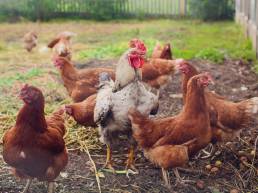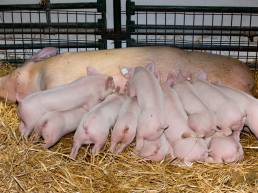Mycotoxins are an underestimated problem in livestock.
More knowledge has been gained in the past few decades about fungi, mycotoxins and their effects. Therefore fungi are more and more recognised as a problem at farms.
Due to this recognition, dairy farmers are already paying more attention to proper ensilage management. Furthermore bad (mouldy) spots in silages are fed less often. Nonetheless, silage often contains high levels of fungi and mycotoxins. In practice two scenarios appear frequently.
The first possibility is that fungi brought in from the field continue to grow in the silage during storage. After ensilage a natural fermentation process occurs in order to preserve the silage. The fungi already present in the silage become active, produce mycotoxins and continue to develop. This mycotoxins already present in the silage will be fed.
In the second scenario the fungi present in well-preserved silage become active as soon as the silage is collected for feeding. Generally only a small proportion of the fungi is visible in the silage, making it difficult to assess the location of mycotoxins. As mycotoxins are also odourless and flavourless, they are fed without being noticed. The rumen of dairy cows is able to deactivate low levels of mycotoxins, but the rumen is not capable to inactivate high levels of mycotoxins. The latter will cause latent problems at thefarm such as fertility issues, ketosis, mastitis, more frequent problems with retained placenta and lower milk production.
E.F.S. believes that nature has a solution for everything. In our opinion, nature provides various solutions against mycotoxins, some of which are combined in our product Tox-Aid®:
- Natural binding by clay minerals.
- Changing the structure of mycotoxins into a harmless substance via enzymes present in yeast.
Combined with additional intestinal protection through special herbs, cattle are protected against the negative effects of mycotoxins with 1030 gram Tox-Aid®/cow/day.
Curious? Contact the E.F.S. team!
You may also like
Tox-Aid® organic authorisation
June 29, 2020
Tox-Aid® is on the organic input list! Tox-Aid® has been authorised for use in organic feeds to limit the negative effects of mycotoxins in the animal. This product has a three-stage effect, i.e. deactivation by means…
Tox-Aid®: Also deactivates Fumonisin and Ochratoxin
May 20, 2017
Tox-aid® is a natural solution that deactivates mycotoxins. In three steps mycotoxins in the animal are rendered harmless. E.F.S. believes nature has a solution for everything. However, this also needs to be…
Tox-Aid®: Masked Mycotoxins
January 28, 2017
E.F.S. believes that nature has a solution for everything. Mycotoxins are part of a natural process and it appears that masked mycotoxins are present in crops, feed materials and feed. Maybe you have already heard the…






